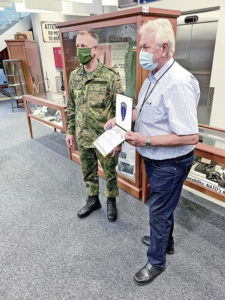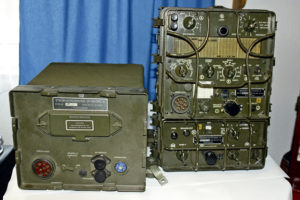
Franz Badjon, a German national from Malmsheim near Stuttgart, donated a historic German navy Cold War era radio to the U.S. Army Europe Museum in the Mission Command Center on Clay Kaserne in June. Badjon, a former wireless radio operator in the German navy, used the radio set in the 1960s to communicate with NATO.
“Interoperability is fundamental to America’s efforts and work with NATO,” said Lt. Col. Brian D. Andrews, Liasion Officer to United States European Command at Stuttgart.
Badjon and Andrews became good friends during Andrews’ second tour in Europe from 2014-2016 when they were neighbors. He knew about the radio, which was stored in the basement of Badjon’s house eating up space, but which also carried a sentimental value for Badjon, Andrews said.
He is now on his third tour in Germany. One evening, when sitting with Badjon, Andrews came up with the idea of giving the radio set a new purpose as a display piece in the MCC, he said.
Andrews, David Fulton, director of the MCC, Dr. Harold Raugh, U.S. Army Europe historian, and Frederick Adolthus, museum curator, arranged everything, including a ceremony of appreciation Aug. 20 for Badjon and his wife Traute during which the display was unveiled. They were awarded with a certificate of appreciation and a coin by U.S. Army Europe Chief of Staff Brig. Gen. Jared Sembritzki.

The radio set has a special meaning from a military point of view, Andrews said. There are three fundamental elements to a successful military: shoot, move and communication. The radio anchors in the communication element.
After World War II, German and American communications technologies were not designed to be compatible, Andrews said. So the Americans licensed their technology to the Germans and other NATO partners to increase interoperability.
“This why we share technology like this radio with our allies,” Andrews said.


